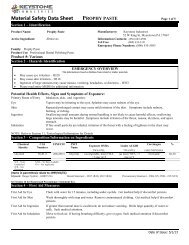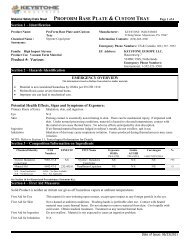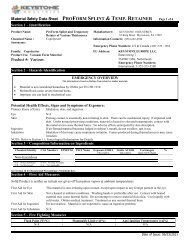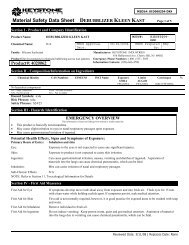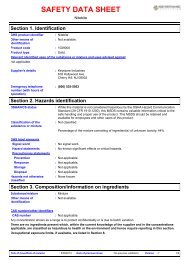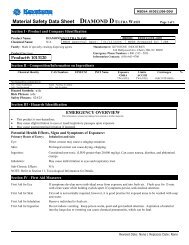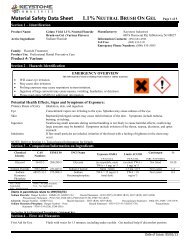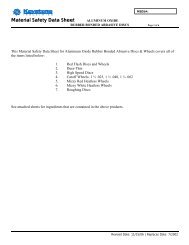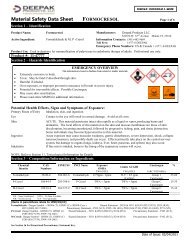DIAMOND D® HEAT CURE ACRYLIC - Keystone Industries
DIAMOND D® HEAT CURE ACRYLIC - Keystone Industries
DIAMOND D® HEAT CURE ACRYLIC - Keystone Industries
You also want an ePaper? Increase the reach of your titles
YUMPU automatically turns print PDFs into web optimized ePapers that Google loves.
Diamond D ® Heat Cure<br />
Processing Instructions:<br />
1. Flask<br />
Wax up, flask, and boil out in the usual manner. Make<br />
sure all surfaces are wax free before proceeding. For<br />
mold washout, we recommend Diamond D Ultra Wash.<br />
When steam has stopped rising from the cast, apply<br />
Diamond D Ultra-Sep Tinfoil Substitute to all mold<br />
surfaces. Avoid coating teeth with this material since<br />
this can result in poor adhesion between teeth and the<br />
denture acrylic. If teeth are coated with tin foil substitute,<br />
remove it from the teeth with the Diamond D Sep Brush<br />
II and a little monomer.<br />
2. Mixing<br />
Slosh/roll powder container before each use to insure<br />
proper fiber dispersion. Powder/Liquid Ratio by<br />
weight: 10 ml monomer to 21g powder. Powder/<br />
Liquid Ratio by volume: 10 ml monomer to 30 cc<br />
powder.<br />
For optimal results follow the above ratios and process<br />
at ambient room temperature. Measure liquid and pour<br />
into a glass mixing jar with lid. Shake the powder to<br />
evenly distribute the fibers. Measure powder and add<br />
enough to the liquid while stirring until the liquid is<br />
completely absorbed. Tap the jar on the bench top to<br />
bring the remaining monomer to the surface and add<br />
any remaining powder. Stir with a stainless steel spatula<br />
until all the powder is moistened. Cover and let the<br />
acrylic rest until it pulls away from the sides of the<br />
jar and does not stick to the stainless steel spatula.<br />
Estimated time for Diamond D Heat Cure Acrylic to reach<br />
packing stage is 7 minutes to 14 minutes depending on<br />
ambient air temperature.<br />
3. Packing<br />
DO NOT LET <strong>ACRYLIC</strong> REACH “SNAP STAGE”. Acrylic<br />
that is packed too dry can result in brittleness, porosity<br />
and shade discoloration. Estimated working time after<br />
the material has reached packing stage is 5 to 7<br />
minutes. The flask should be at room temperature 60˚<br />
- 80˚F (15˚ - 27˚C) prior to packing. Remove the acrylic<br />
from the mixing jar. Trial pack denture 2-3 times to<br />
insure minimized porosity and maximum acrylic density.<br />
Use sufficient pressure with each trial pack and remove<br />
excess acrylic using polyethylene sheets as a separator<br />
between each trial pack. Remove the flask and close<br />
final without the polyethylene sheet. For best result<br />
allow clamped flask to sit on bench or in room temp<br />
water bath for 20-30 minutes to allow residual internal<br />
exothermic heat to subside, then begin curing process.<br />
4. Processing<br />
Water temperature is critical in the processing of all<br />
denture acrylics. Polymerization generates high temperatures<br />
inside the flasks. If the flask is put immediately<br />
into boiling water the liquid resin may boil and cause<br />
porosity in the denture base. The curing cycles below<br />
insure porosity free castings. For thicker cases bench set<br />
in flask compress for 30 minutes before introducing into<br />
165˚F (73˚C) water bath and process through the normal<br />
curing cycle.<br />
Long Cure - Immerse flask into room temperature<br />
water, rise to 165˚F (73˚C) and maintain that temperature<br />
for 8 - 9 hours.<br />
Heat polymerization/long cure Option 1<br />
After 20 minute resting period place packed or injected<br />
and clamped flask into room temperature water bath and<br />
raise temperature to 165˚F (73˚C). Hold at temperature<br />
overnight or 8 -10 hours. If desired an optional boil<br />
for final 30 minutes of long cycle is possible. Remove<br />
from bath and allow flask to cool on the counter for 20<br />
minutes before final immersion in lukewarm water for<br />
final cool. Deflask and finish.<br />
Short Cure - Immerse flask into room temperature<br />
water, rise to 165˚F (73˚C) and maintain that temperature<br />
for 90 minutes. Then raise temperature to a boil and<br />
hold for 30 minutes.<br />
Heat polymerization/short cure Option 2<br />
After 20 minute resting period place packed or injected<br />
and clamped flask into room temperature water bath and<br />
raise temperature to 165˚F (73˚C). Hold for 90 minutes,<br />
and then raise temperature to a boil 212˚F (100˚C)<br />
and hold for 30 minutes. Remove from bath and allow<br />
flask to cool on the counter for 20 minutes before finial<br />
immersion in lukewarm water for final cool. Deflask and<br />
finish.<br />
5. Deflasking<br />
When the flask is cool enough to handle, place it under<br />
warm water for 20 minutes or bench cool for 45 minutes<br />
(recommended) then deflask in the usual manner. In the<br />
case of undercuts, do not pry the denture with a knife<br />
or distortion of the denture could result. Section the cast<br />
instead to insure a superior fit. Keep unfinished denture<br />
in a moist environment until it can be finished.<br />
6. Finishing and prosthesis storage<br />
After post process equilibration, prosthesis is removed<br />
from cast and trimmed with conventional crosscut burs.<br />
Prior to pumicing, miniature Scotchbrite wheels can<br />
provide a pre-pumice surface allowing for ideal finial<br />
polishing. It is always recommended to store prosthesis<br />
in water during the course of finishing and until it is<br />
inserted in mouth.<br />
7. Product Storage<br />
Powder and liquid should be stored in a temperature<br />
constant area not to exceed 75˚F (25˚C). Avoid storage in<br />
direct sunlight.<br />
*Always practice Good Manufacturing Practice protocols<br />
regarding the non-mixing of powders or liquids of one<br />
manufacture with another.<br />
NOTE: When tested according to ADA/ANSI Spec.<br />
#12, 8.7, the maximum residual monomer content<br />
of Diamond D heat cure material, when processed as<br />
outlined above, will be less than 2%.



